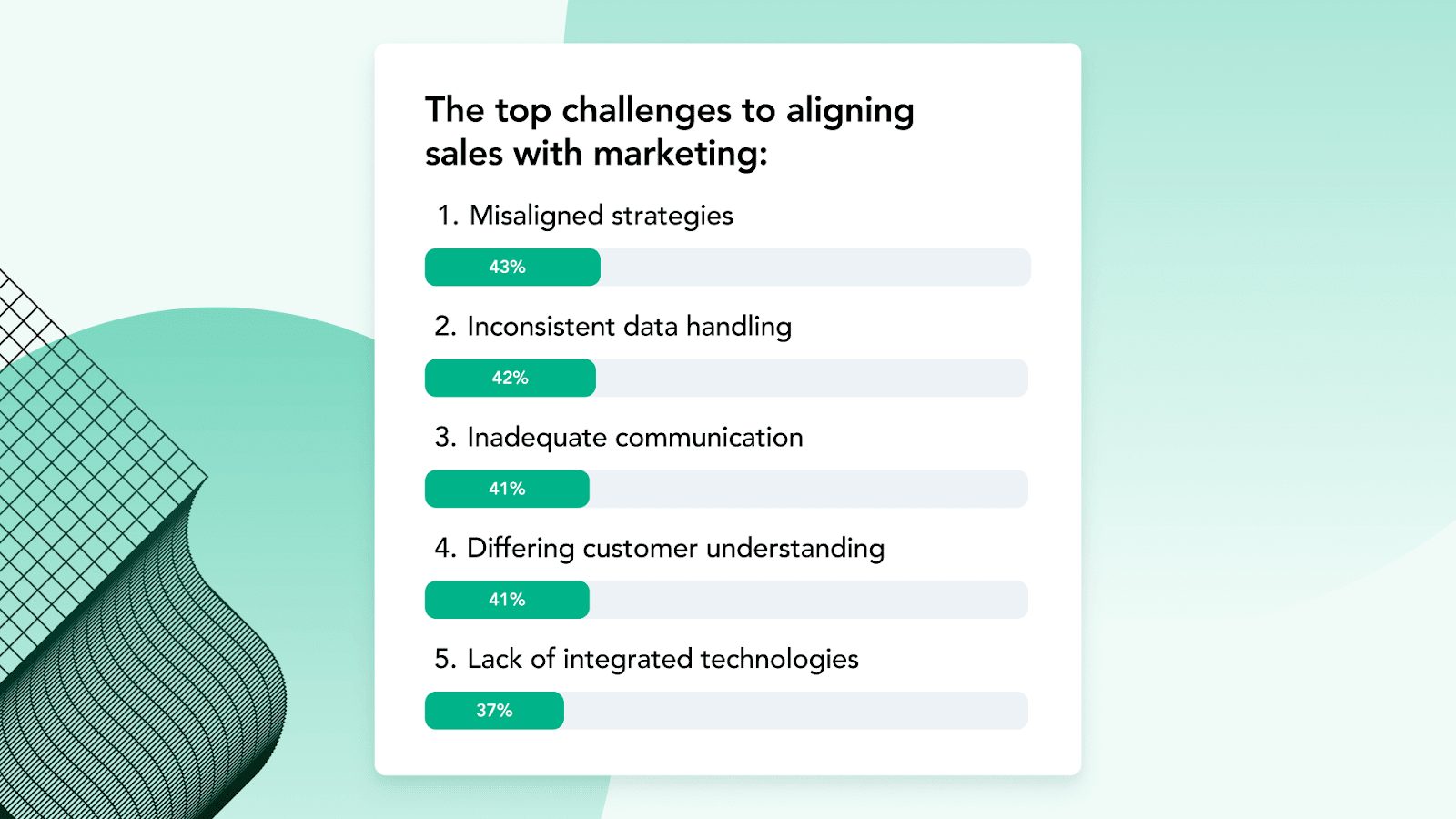It’s no secret that many B2C sales and marketing teams go together about as well as peanut butter and ketchup. They often work in silos with little meaningful communication or collaboration. While they’re both responsible for driving revenue, they often lack the cohesive, shared strategy required to achieve it. This misalignment causes serious issues that put a wrench in pipelines and stifle revenue growth.
In this blog post, we break down the most common challenges that cause disconnects between B2C sales and marketing teams. We also dive into how leading companies solve these challenges with revenue execution platforms.
Challenge 1: Misaligned Objectives
In our recent State of B2C Revenue Execution Report, we discovered that poor alignment between marketing and sales at B2C companies is due to several interrelated factors. The leading cause is a lack of alignment on strategy. While both departments have a vested interest in driving more revenue, they are heavily siloed and function independently from each other. The left hand doesn’t know what the right hand is doing and, as a result, they can’t collaborate effectively.
For example, let’s say a marketing team prioritizes sending a high volume of leads to the contact center. Unbeknownst to marketing, the contact center team doesn’t have the capacity to handle all of those leads, which results in long hold times, low conversion rates, and wasted marketing spend. This problem could have been avoided if the teams aligned their objectives to focus on high-quality leads rather than prioritizing quantity.
In other cases, marketers may be hyperfixated on metrics like MQLs, cost per acquisition, web visitors, and CPC, which may not have a direct impact on the sales team’s success and the organization’s overall goal of driving revenue.

Challenge 2: Inconsistent Data Handling
If your teams use different data from different sources, they’ll likely have different interpretations of the buying journey. For example, if your teams aren’t looking at the same data or just don’t have access to half of it, it’s easy to point fingers at one another when conversion rates dip. The classic argument is doomed to rear its ugly head: marketing says sales isn’t closing the scorching hot leads they send, and sales says the leads are ice cold.
This argument leaves teams at a standoff and is counterproductive to the goal of driving revenue. The best way to overcome it is to create a designated data hub that serves as a single source of truth for both teams. With this single source of truth, marketing and sales teams can align on a shared set of KPIs and work toward them together, rather than pointing fingers.
To solve this challenge, as well as the prior one, leading companies use revenue execution platforms. These solutions track the entire online-to-offline buyer journey, so marketing and sales teams can align around the most important metric of all — revenue. Revenue execution creates a common language between the teams, so nothing gets lost in translation.
Challenge 3: Inadequate Communication
Another issue many marketing and sales teams identified is cultural barriers hindering their collaboration. The departments are siloed and each has its own metrics, software tools, and way of managing employees. In many organizations, the two teams don’t have regular communication cadences and they begin to drift apart.
Overcoming the cultural barriers between departments, however, is easier than you may think. In our State of B2C Revenue Execution Report, 84% of people said meeting more regularly with their counterparts in marketing or sales would positively impact their ability to drive revenue. Bridging the divide can be as simple as setting a regular cadence to connect with your counterparts and approaching them with inquisitiveness and empathy. When you make a sincere effort to understand where your colleagues are coming from, you can work collaboratively to devise strategies that benefit the entire organization.
Challenge 4: Inconsistent View of the Customer
Today’s buying journey is more complex than ever, as consumers bounce between numerous channels and devices to complete purchases. For example, a consumer may see an ad on Facebook for a sales event at a local dealership, search for the dealership on their phone, visit the dealer’s website, and then place a call to set up a test drive.
Many B2C organizations can track online conversions accurately, but when it comes to offline conversions like phone calls, the data trail goes cold. This makes it difficult for marketers to understand and optimize efforts that drive phone leads and conversions. As a result, they can’t spend their budget efficiently.
In addition, an inconsistent view of the digital journey can cause issues for sales teams. For example, when the contact center lacks information about the digital journey that drove the call, they don’t have the information they need to quickly address the caller’s needs. The call may need to be transferred or put on hold, frustrating everyone who calls and reducing contact center efficiency. This in turn will reduce conversion rates, directly impacting revenue growth.
Revenue execution platforms solve this problem by giving marketing and sales teams a view of the entire digital-to-call experience. This allows teams to understand how well each marketing program drives phone leads and how well sales converts those leads. In addition, revenue execution platforms give sales agents data about each caller’s digital journey before the call is connected so they can personalize greetings and quickly dive into solving issues.
Challenge 5: Lack of Integrated Technologies
Marketing and sales teams use more software than ever for everything from tracking ad performance to analyzing phone calls. The problem is much of this technology isn’t integrated across marketing, sales, and contact centers, so all of the data you are collecting and analyzing is underutilized and often inaccessible to those who need it.
Without a cohesive technology strategy, companies face serious alignment issues. Below are some problems that arise:
- Inconsistent online-to-offline experiences: Without integrated technologies, sales teams don’t have the information they need to create cohesive online-to-offline journeys. They may incorrectly route callers, leave them on hold, or fail to give them personalized greetings, resulting in a poor customer experience.
- Limited personalization and targeting: Today’s consumers have higher experience expectations than ever before. They expect every interaction to be tailored to their needs and specifications. Without integrated technologies, sales and marketing teams can’t tap into the wealth of customer insights at their disposal and use them for personalization and targeting.
- Misaligned goals and metrics: Marketing teams are often focused on metrics like cost per click, clickthrough rate, MQL, cost per acquisition, and web visits, rather than revenue. This isn’t because they don’t care about revenue growth, they just don’t have visibility into the bottom of the funnel. These metrics are their best proxy for revenue, but they can often be misleading.
- Reduced productivity: When you don’t have integrated technologies, you waste time searching for data across platforms and manually stitching it all together. This strains teams’ bandwidth and manual processes are prone to human error.
- Difficulty in scaling operations: To scale your business, you need to measure what’s working and what’s not so you know where to focus your efforts. However, without integrated technologies, you may not have the right data to guide organizational decisions.
Revenue executions solve this issue, as they easily integrate with the marketing and sales tools your team uses every day. They aren’t just another tool to add to an already crowded technology stack — they seamlessly plug into the workflows you use every day.
How Revenue Execution Platforms Improve Sales and Marketing Alignment
Revenue execution platforms are AI-powered software solutions that connect the entire customer buying journey. They work by bridging the data gap between the marketing team that engages customers and the sales teams that close the deals. This creates a cohesive view of the revenue journey for interactions that take place online and conversion actions that happen over the phone.
This unified view allows marketing, sales, contact center, and customer experience teams to connect their investments directly to revenue. As a result, they can take the right steps to drive high-quality leads, convert those leads at a higher rate, and streamline the buyer journey.

For example, with a revenue execution platform, the marketing team can track how many phone leads each campaign, channel, and keyword drives. Not only that, but they can see how well the sales team handled those leads and converted them to revenue. With this full-funnel view, they can spend more on the campaigns that work and cut the ones that don’t. They can also collaborate with the sales team to ensure more of the leads they drive convert to revenue.
With a revenue execution platform, the sales team can track the percentage of marketing leads that are high quality, rather than taking the team’s word for it. If they discover a lot of low-quality leads are coming through, they can work with marketing to increase lead quality. The sales team can also use revenue execution tools to increase close rates by enhancing routing, giving agents pre-call data about caller intent, and automating call scoring.
As a result, your sales and marketing teams can get the data and visibility they need to understand what parts of the process may be failing. You’ll gain a complete understanding of the buying journey and a common language to speak in. You can then chart a clear path to reach the common goal — driving revenue growth.
Additional Reading
Want to learn more about how Invoca’s revenue execution platform can help you drive marketing and sales alignment? Check out these resources:
- How Real-Time Revenue Execution Platforms Drive Business Growth
- Why Revenue Leaders Need a Revenue Execution Platform to Drive Sustained Growth
- Revenue Growth Slowed by B2C Brands’ Struggle With Marketing and Sales Team Alignment


